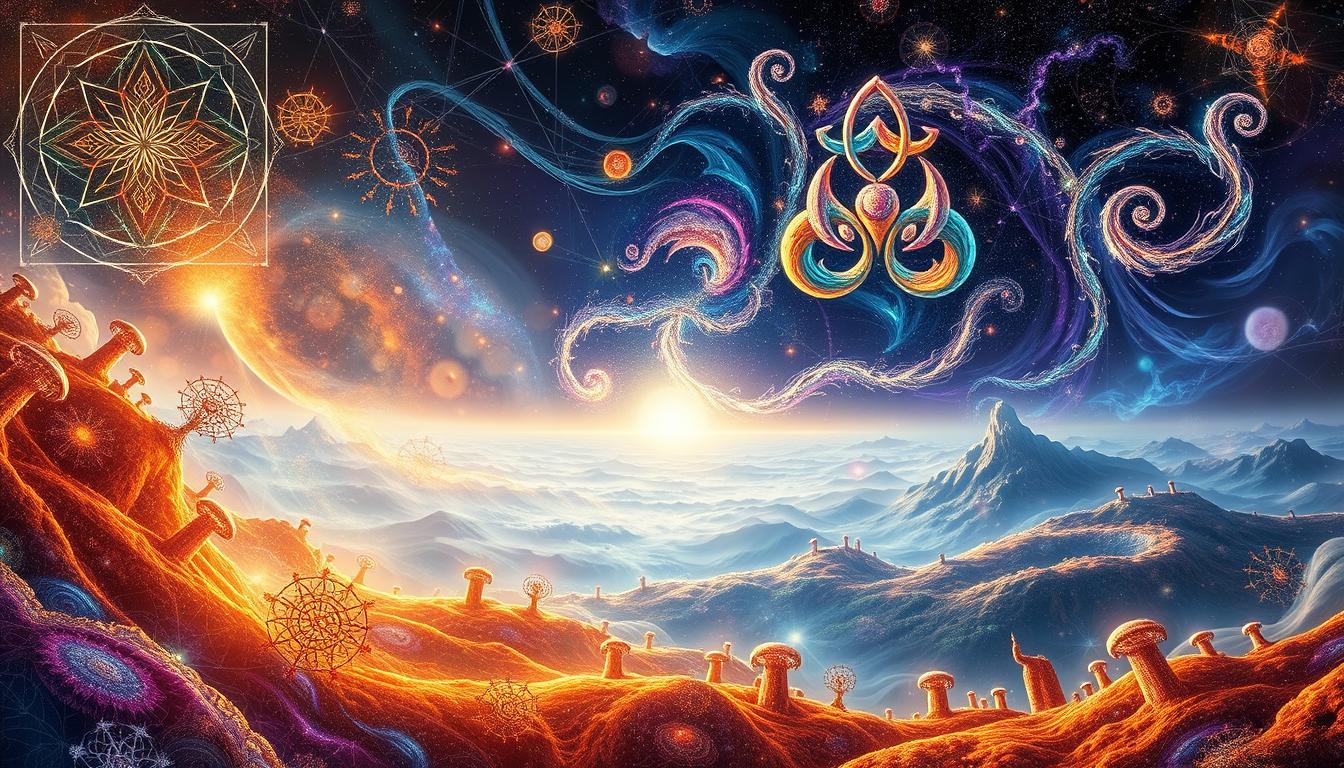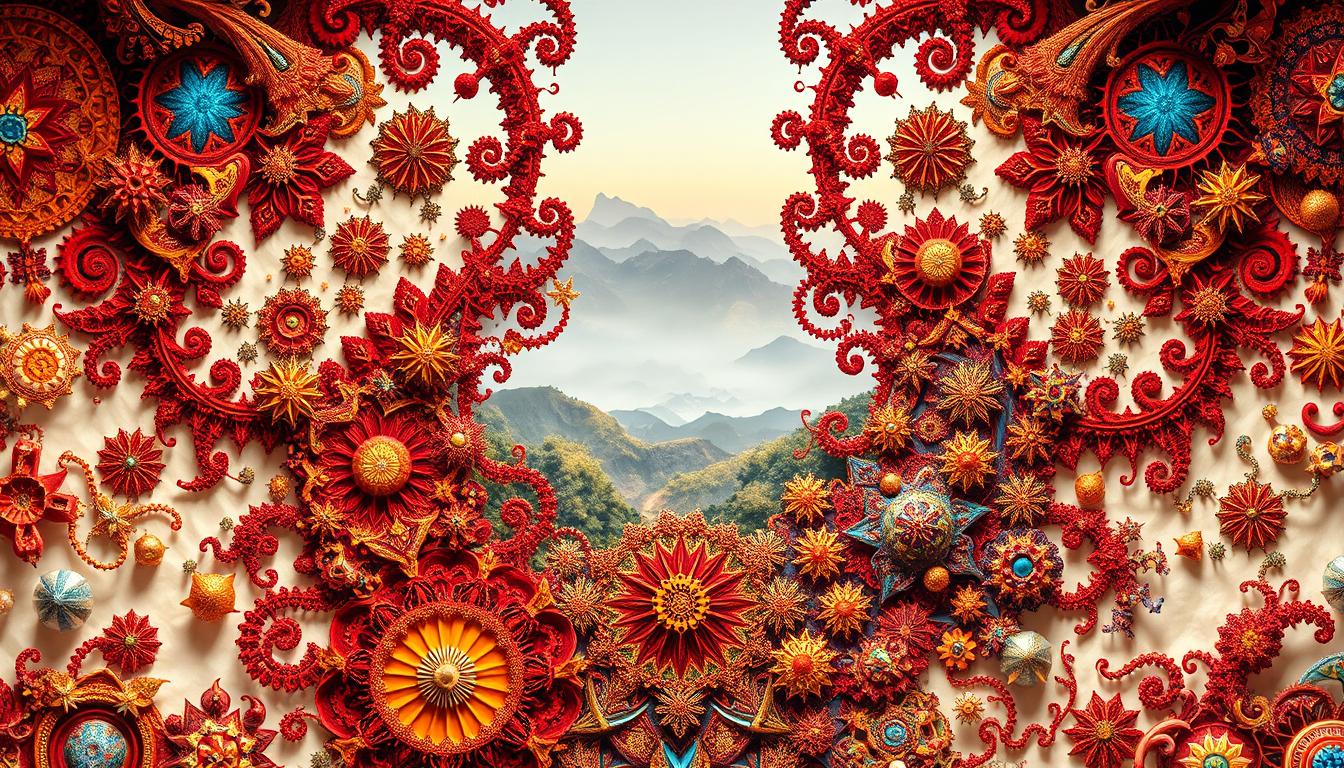Fractals show us the beauty of nature’s complex geometry. They repeat similar patterns at different sizes. Indigenous wisdom aligns with this, seeing everything as connected.
This article connects fractals and indigenous insights. It shows how both understand the importance of patterns. They help us know our world and our bond with it.
The Concept of Fractals: An Overview
Fractals are stunning math structures with patterns that repeat at different sizes. They are not just in math but also in nature. The Mandelbrot set is a famous fractal showing these patterns and their meanings.
Defining Fractals
Fractals are about self-similarity, where small parts look like the whole thing. You can see fractals in tree branches and mountains. This shows how complex and beautiful they are, making us want to learn more about them.
The Mathematical Significance of Fractals
Fractals are more than just pretty. They help model natural things like coastlines and clouds. This shows math in the world around us. With fractals like the Mandelbrot set, mathematicians learn about nature’s systems.

Indigenous Wisdom: A Holistic Perspective
Indigenous wisdom uses a holistic view to understand the world. It’s based on traditional knowledge, showing how humans and nature are closely linked. Through stories and oral traditions, this wisdom is passed down, keeping cultural practices alive across generations.
Understanding Indigenous Knowledge Systems
Indigenous knowledge offers unique insights into living in harmony with nature. These systems gather centuries of experiences, suggesting ways to adapt to our changing world. They highlight the importance of biodiversity and teach us to respect nature as a living being.
The Role of Oral Traditions and Storytelling
Oral traditions are key in sharing knowledge in indigenous communities. Storytelling carries valuable lessons and moral values from one generation to the next. These stories highlight nature’s cycles in ways that relate to human life. They not only keep cultural heritage alive but also build strong community ties, encouraging us to care for our environment together.
The Connection Between Fractals and Indigenous Wisdom
Studying fractals shows a connection with indigenous wisdom, especially in understanding patterns and relationships. Both areas stress seeing how things in nature connect. This link helps explain how indigenous knowledge deals with the complex patterns found in the natural world.
Similarities in Patterns and Relationships
Fractals and indigenous beliefs share a view on nature. They show how nature’s patterns, like tree branches or river paths, reveal deep connections among living things. These repeating patterns teach us the value of ecological balance.
This common ground enhances our grasp of how everything in an ecosystem fits together. Every part has its place and role.
Indigenous Interpretations of Natural Patterns
Indigenous peoples have long appreciated nature’s intricate patterns. These designs are beautiful and hold cultural and ecological significance. They blend spiritual and practical knowledge, similar to the beauty of fractals.
This combination of fractal and indigenous insights offers a deeper way to see and interact with our world.
Fractals in Nature: Examples and Significance
Fractals are everywhere in nature, showing the bond between plants and animals. We learn more about how ecosystems work by studying these patterns. They remind us of Earth’s deep complexity.
Patterns in Flora and Fauna
Trees and leaves show fractals with their repeating shapes. Each tree branch divides into smaller ones, showing fractals in action. The way flowers and seeds arrange themselves, like sunflower spirals, is also a fractal.
In animals, we see fractals in fish scales and mollusk shells. These patterns are key for their survival and how they adapt to their surroundings.
The Importance of Ecosystems
Fractals do more than just look pretty; they show how vital ecosystems are. They depend on species working together within these patterns.
Plants, animals, and microorganisms maintain balance in nature. By understanding them, we gain deeper respect for nature and see why it’s crucial to protect biodiversity.
Complexity Theory and Indigenous Worldview
Complexity theory helps us understand how systems interact in different areas. It fits well with the indigenous way of seeing the world. They both value knowing how things are connected and how these connections make up our world. Looking at these ideas together shows us how important connections are in nature and society.
How Complexity Theory Relates to Indigenous Knowledge
Complexity theory looks at how linked systems create new outcomes. This is similar to indigenous knowledge, which is all about understanding connections. Indigenous people see everything as part of a bigger picture. Everything – plants, animals, humans – has an important role in life’s network. This view helps us understand ecosystems as a whole, where every link matters.
The Importance of Relationships in Both Systems
Both complexity theory and the indigenous worldview show us how vital connections are. They teach us that understanding our links to others and to nature is key. Combining these views leads to teamwork and respect, aiming for a sustainable balance. Valuing these ideas together deepens our insight into life.
Fractal Ontology: A Philosophical Approach
Fractal ontology offers a deep way to see how things connect in nature. It draws from old wisdom, like mtig bemaadzid, the living tree idea. Through this viewpoint, we see life’s patterns reflecting the deep-rooted beliefs of indigenous cultures.
Understanding Fractal Ontology in Indigenous Contexts
In indigenous contexts, fractal ontology shows us how all parts of nature relate. It teaches that everything is one—people, plants, and animals all intertwined. This concept reminds us to respect nature and value our connections within it.
The Idea of Interconnectedness in Nature
Interconnectedness is key in fractal ontology and indigenous views on nature. Nature is seen as a unified system, not just separate parts. This encourages us to maintain a balanced, harmonious relationship with the environment.
Digital Archiving of Indigenous Knowledge
Technology has changed how we keep and share indigenous knowledge. Digital archiving helps save old wisdom while making sure it stays available for the future. It lets indigenous communities keep control over their knowledge, respecting information sovereignty.
The Impact of Technology on Indigenous Wisdom
Technology brings new ways to save and spread indigenous knowledge. Digital platforms let us save spoken stories, languages, and cultures in new formats. Using technology, communities strengthen their cultural identity and connect more with their heritage.
Fractal Models in Digital Archiving
Using fractal models in archiving is a creative method. These models organize information to show how everything is connected. Fractal patterns help digital archives mirror natural relationships in knowledge.
This makes navigating information easier and keeps the original essence. It shows how technology plays a big role in preserving cultures.
The Role of Art in Expressing Indigenous Knowledge
Indigenous art is a deep way to show culture and beliefs. It uses patterns that show life and nature are connected. Through art, communities share their identity and wisdom. They use art to pass down knowledge to future generations.
Indigenous Art as a Reflection of Fractal Patterns
Indigenous art has designs that reflect fractal patterns. These patterns show how everything in nature is related. Artists are inspired by the world around them. They use art to talk about life and how everything is connected.
The Cycle of Creation in Indigenous Creativity
Cycles of creation are key in indigenous art, showing how life goes on. Art shows this cycle where things are always being created. It shows change and renewal. Through their art, artists share messages and wisdom from their ancestors. This idea connects people to their history and the earth. It shows the need to take care of our world.
Challenges in Recognizing Indigenous Wisdom
Understanding indigenous knowledge is not easy due to colonial impacts. These views often dismiss traditional wisdom, making it hard to see its value. Colonial stories continue to affect how we value indigenous knowledge.
Colonial Perspectives and Their Limitations
Colonial ideas tend to see indigenous knowledge as old or simple. This misses the deep understanding these communities have about nature, living sustainably, and relationships. Such attitudes block the respect and recognition of indigenous insights, keeping wrong beliefs alive.
Bridging the Gap Between Western and Indigenous Epistemology
Merging different ways of knowing means seeing the value in both Western and indigenous ideas. Working together opens paths for respect and valuing indigenous viewpoints. This helps everyone learn more, enriches all our knowledge, and supports taking care of the earth using ancient wisdom.
Modern Applications: Learning from Indigenous Wisdom
Indigenous wisdom is key, especially about sustainability and protecting the environment. By blending ancient practices with today’s methods, we can change education for the better. It teaches students to live in harmony with the Earth.
Integrating Fractal Patterns into Modern Education
Teaching fractal patterns helps students see nature’s connections. It makes them understand how everything in the ecosystem is linked. By using fractal learning, lessons become more interactive, showing how indigenous knowledge works today.
Schools are now using projects that highlight these patterns. This helps students see the importance of keeping the planet healthy.
Examples of Indigenous Practices Influencing Sustainability
Many indigenous methods are perfect examples of sustainability. They include:
- Permaculture techniques that promote biodiversity.
- Resource management that respects natural rhythms.
- Community engagement in environmental stewardship.
As we face environmental issues today, these age-old traditions are vital. They teach us how to create a sustainable world. Mixing these traditions with modern education can make our future greener.
Conclusion
When we look closely at fractals and indigenous wisdom, we see they both understand how everything is connected. Fractals show us nature’s repeating patterns, similar to cycles in indigenous cultures. These patterns are more than math; they’re symbols of life and our world.
Valuing indigenous wisdom helps us grasp complex systems, just like fractals do in math. This wisdom views ecosystems and communities as wholes, showing how we’re all linked to nature. By combining fractal and indigenous insights, we can move towards sustainability and value both math and culture more.
Exploring fractals and indigenous wisdom changes how we see and relate to the world. By appreciating both, we learn more about our role in life’s interconnected web. This journey reveals the beauty in both math patterns and indigenous stories.



